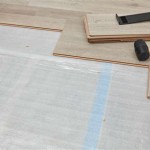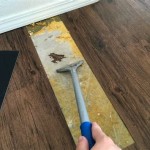```html
Can You Put Laminate Flooring Over Tile? A Comprehensive Guide
Laminate flooring is a popular choice for homeowners seeking an affordable and aesthetically pleasing alternative to hardwood. Its durability and ease of installation contribute to its widespread appeal. One common question that arises during renovation projects is whether laminate flooring can be installed directly over existing tile. The answer is generally yes, but several factors must be carefully considered to ensure a successful and long-lasting result.
Preparation is Paramount for a Successful Installation
Prior to installing laminate flooring over tile, thorough preparation is critical. This includes assessing the condition of the existing tile, addressing any imperfections, and ensuring a level and clean surface. Failure to properly prepare the subfloor can lead to problems such as uneven flooring, premature wear, and compromised structural integrity. The longevity and appearance of the new laminate floor are directly linked to the quality of the preparation process.
The initial step involves a comprehensive inspection of the existing tile. Look for cracked, loose, or uneven tiles. Any imperfections must be addressed before proceeding with the laminate installation. Loose tiles should be removed and the resulting gaps filled with a suitable patching compound. Cracked tiles, if not severely damaged, can be repaired with epoxy or patching compounds designed for tile repair. However, heavily damaged tiles should be removed entirely and replaced or patched.
Leveling the surface is equally important. Laminate flooring requires a relatively flat and even subfloor. Significant variations in height between tiles can create an uneven surface, which can not only be unsightly but also compromise the locking mechanisms of the laminate planks. A self-leveling compound can be used to address any unevenness. Apply the compound according to the manufacturer's instructions, ensuring it fills any low spots and creates a smooth, level surface. Multiple applications may be necessary to achieve the desired flatness. A straight edge and level can be used to check for any remaining imperfections.
Cleaning is another essential step. The tile surface must be thoroughly cleaned to remove any dirt, grime, or debris that could interfere with the underlayment and laminate flooring adhesion. Use a suitable cleaning solution and scrub the tile surface thoroughly. Rinse with clean water and allow the surface to dry completely before proceeding. This ensures a clean and stable base for the new flooring.
Finally, consider the type of tile you are working with. Smooth, glazed tiles might require a bonding agent to enhance adhesion between the tile and the underlayment. Consult with a flooring professional or adhesive manufacturer to determine the appropriate bonding agent for your specific tile type and underlayment.
The Importance of Underlayment for Laminate Over Tile
Underlayment is a crucial component when installing laminate flooring over tile. It serves multiple purposes, including providing a cushioning layer, reducing noise transmission, and acting as a moisture barrier. Selecting the correct type of underlayment is essential for optimizing the performance and longevity of the laminate floor.
One of the primary functions of underlayment is to cushion the laminate planks, reducing the impact of foot traffic and minimizing noise. Tile is a hard, unforgiving surface, and without underlayment, the laminate flooring would be susceptible to damage and noise transmission. A good quality underlayment will absorb some of the impact and help to prevent the laminate planks from cracking or breaking, especially at the joints. This can extend the lifespan of the laminate flooring and improve its overall comfort.
Noise reduction is another important benefit of underlayment. Tile can amplify sounds, and without underlayment, footsteps on the laminate floor could be quite noisy. Underlayment acts as a sound barrier, absorbing vibrations and reducing the transmission of sound to the rooms below. This is particularly important in multi-story homes or apartments where noise levels need to be minimized.
Moisture protection is also a critical consideration. Tile is generally waterproof, but moisture can still penetrate through grout lines or imperfections in the tile. Underlayment with a built-in moisture barrier can help to protect the laminate flooring from moisture damage. This is especially important in areas such as kitchens and bathrooms, where moisture levels are typically higher. A vapor barrier is generally recommended, particularly in basements or concrete slabs.
There are various types of underlayment available, each with different properties and benefits. Foam underlayment is a popular choice due to its affordability and ease of installation. Cork underlayment offers excellent noise reduction and insulation properties. Rubber underlayment is known for its durability and moisture resistance. Consider the specific requirements of your project and choose an underlayment that provides the appropriate level of cushioning, noise reduction, and moisture protection. Verify the R-value of the underlayment to ensure it meets the thermal insulation requirements of your region.
Addressing Potential Drawbacks and Considerations
While installing laminate flooring over tile offers several advantages, it is important to be aware of potential drawbacks and considerations. These include increased floor height, potential moisture issues, and the possibility of telegraphing imperfections from the tile surface. Addressing these concerns proactively can help to ensure a successful and satisfactory outcome.
One of the most significant drawbacks is the increase in floor height. Adding laminate flooring and underlayment on top of existing tile can raise the floor level, which can create problems with doorways, transitions to other rooms, and appliances. Consider the height difference carefully and determine whether it will create any obstacles or safety hazards. Trimming doors may be necessary to accommodate the increased floor height. Transition strips can be used to create a smooth transition between the laminate floor and other flooring types. The existing door frames must be evaluated to ensure adequate clearance.
Moisture problems can also be a concern, especially if the tile is installed over a concrete slab or in a damp environment. While tile is generally waterproof, moisture can still wick up through the slab and penetrate the grout lines. This moisture can then become trapped under the laminate flooring, leading to mold and mildew growth. Implementing a robust moisture barrier is crucial. Properly sealing grout lines and installing a vapor barrier under the underlayment can help to prevent moisture from damaging the laminate floor. Regular monitoring for signs of moisture is also recommended.
Telegraphing refers to the phenomenon where imperfections in the subfloor transfer through to the finished flooring surface. If the tile surface is not perfectly flat and even, any bumps or dips can become visible in the laminate floor. This can be particularly noticeable with thinner laminate planks. Proper preparation, including leveling the tile surface with a self-leveling compound, is essential to minimize the risk of telegraphing. Using a thicker underlayment can also help to cushion the laminate floor and reduce the visibility of minor imperfections.
In addition to these considerations, it's also important to be aware of any potential warranty issues. Some laminate flooring manufacturers may void the warranty if the flooring is installed over tile. Consult the manufacturer's instructions and warranty information before proceeding with the installation. Verifying compliance with local building codes is also imperative prior to commencing the flooring project.
Before undertaking this project, obtaining professional advice from a flooring contractor is highly advisable. A contractor can assess the specific conditions of the subfloor, provide recommendations on the best materials and installation techniques, and identify any potential problems before they arise. This can save time, money, and frustration in the long run, ensuring a successful and long-lasting laminate flooring installation.
```
Can You Put Laminate Flooring Over Ceramic Tiles Mellowpine

Can You Put Laminate Flooring Over Tile Twenty Oak

Can You Put Laminate Flooring Over Tile Alliance Directory

Can You Put Laminate Or Vinyl Plank Flooring Over Tile

Installing Laminate Tile Over Ceramic Diy Floors Wonderhowto

Installing Laminate Tile Over Ceramic Diy Floors Wonderhowto

Should You Install Vinyl Floor Over Tile

Install Laminate Flooring Over Ceramic Tile

New Vinyl Plank Flooring Over Tile Table And Hearth

Installing Laminate Tile Over Ceramic Diy Floors Wonderhowto
Related Posts








